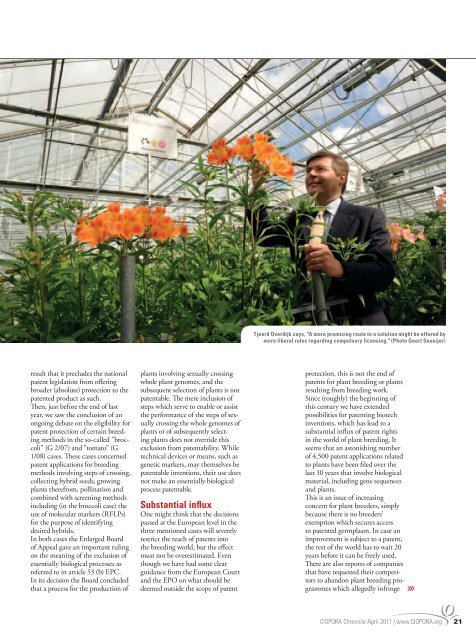2011 CIOPORA Chronicle - the 50th Anniversary Edition
CIOPORA annual magazine on Intellectual Property protection for plant innovations 2011. The magazine was produced in cooperation with FloraCulture International. Read in the 2011 CIOPORA Chronicle edition: - CIOPORA plays vital role in supporting the industry - PVR litigation on the rise - Plant Breeders´Right. Quo vadis? - China deploys national strategy for IPR - CIOPORA helps IP owners protect their rose varieties and much more...
CIOPORA annual magazine on Intellectual Property protection for plant innovations 2011. The magazine was produced in cooperation with FloraCulture International.
Read in the 2011 CIOPORA Chronicle edition:
- CIOPORA plays vital role in supporting the industry
- PVR litigation on the rise
- Plant Breeders´Right. Quo vadis?
- China deploys national strategy for IPR
- CIOPORA helps IP owners protect their rose varieties
and much more...
You also want an ePaper? Increase the reach of your titles
YUMPU automatically turns print PDFs into web optimized ePapers that Google loves.
Tjeerd Overdijk says, "A more promising route to a solution might be offered by<br />
more liberal rules regarding compulsory licensing." (Photo Geert Snoeijer)<br />
result that it precludes <strong>the</strong> national<br />
patent legislation from offering<br />
broader (absolute) protection to <strong>the</strong><br />
patented product as such.<br />
Then, just before <strong>the</strong> end of last<br />
year, we saw <strong>the</strong> conclusion of an<br />
ongoing debate on <strong>the</strong> eligibility for<br />
patent protection of certain breeding<br />
methods in <strong>the</strong> so-called "broccoli"<br />
(G 2/07) and "tomato" (G<br />
1/08) cases. These cases concerned<br />
patent applications for breeding<br />
methods involving steps of crossing,<br />
collecting hybrid seeds, growing<br />
plants <strong>the</strong>refrom, pollination and<br />
combined with screening methods<br />
including (in <strong>the</strong> broccoli case) <strong>the</strong><br />
use of molecular markers (RFLPs)<br />
for <strong>the</strong> purpose of identifying<br />
desired hybrids.<br />
In both cases <strong>the</strong> Enlarged Board<br />
of Appeal gave an important ruling<br />
on <strong>the</strong> meaning of <strong>the</strong> exclusion of<br />
essentially biological processes as<br />
referred to in article 53 (b) EPC.<br />
In its decision <strong>the</strong> Board concluded<br />
that a process for <strong>the</strong> production of<br />
plants involving sexually cros sing<br />
whole plant genomes, and <strong>the</strong><br />
subsequent selection of plants is not<br />
patentable. The mere inclusion of<br />
steps which serve to enable or assist<br />
<strong>the</strong> performance of <strong>the</strong> steps of sexually<br />
crossing <strong>the</strong> whole genomes of<br />
plants or of subsequently selecting<br />
plants does not override this<br />
exclusion from patentability. While<br />
technical devices or means, such as<br />
genetic markers, may <strong>the</strong>mselves be<br />
patentable inventions, <strong>the</strong>ir use does<br />
not make an essentially biological<br />
process patentable.<br />
Substantial influx<br />
One might think that <strong>the</strong> decisions<br />
passed at <strong>the</strong> European level in <strong>the</strong><br />
three mentioned cases will severely<br />
restrict <strong>the</strong> reach of patents into<br />
<strong>the</strong> breeding world, but <strong>the</strong> effect<br />
must not be overestimated. Even<br />
though we have had some clear<br />
guidance from <strong>the</strong> European Court<br />
and <strong>the</strong> EPO on what should be<br />
deemed outside <strong>the</strong> scope of patent<br />
protection, this is not <strong>the</strong> end of<br />
patents for plant breeding or plants<br />
resulting from breeding work.<br />
Since (roughly) <strong>the</strong> beginning of<br />
this century we have extended<br />
possibilities for patenting biotech<br />
inventions, which has lead to a<br />
substantial influx of patent rights<br />
in <strong>the</strong> world of plant breeding. It<br />
seems that an astonishing number<br />
of 4,500 patent applications related<br />
to plants have been filed over <strong>the</strong><br />
last 10 years that involve biological<br />
material, including gene sequences<br />
and plants.<br />
This is an issue of increasing<br />
concern for plant breeders, simply<br />
because <strong>the</strong>re is no breeders’<br />
exemption which secures access<br />
to patented germplasm. In case an<br />
improvement is subject to a patent,<br />
<strong>the</strong> rest of <strong>the</strong> world has to wait 20<br />
years before it can be freely used.<br />
There are also reports of companies<br />
that have requested <strong>the</strong>ir competitors<br />
to abandon plant breeding programmes<br />
which allegedly infringe >>><br />
<strong>CIOPORA</strong> <strong>Chronicle</strong> April <strong>2011</strong> | www.<strong>CIOPORA</strong>.org 21









